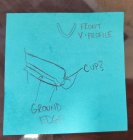This question would most likely bear more fruit over at the Tormek forums, but while I wait for their admins to approve my join request, I thought I'd ask here and get some feedback from you all.
First, my understanding of bowl gouges is that when looking down the front of the gouge, you have two types of flute profiles - a kind of rounded V shape and a U-shape. Based on my experiences, I guess that based on this profile this will determine the grind angle you can produce? The Robert Sorby bowl gouge I have has the rounded V-shape flute profile.
I've had a Tormek T-3 (it's their smaller sharpener, and a generation or so back - I think T4 is the current model) and it's served me well for the 10 years that I've had it. The gouge jig I have is the SVD-185 (current version is SVD-186). When trying to create a fingernail grind with the tool, I'm basically getting a "cup" in the front part of the grind, and then as the wings are being created, there is a very pronounced "edge" at what I would call the "front" of the wings - the point of the wings closest to the middle of the flute at the front of the gouge. I don't have a picture of the gouge available at the moment, so I've attached a crude and more exaggerated drawing of the condition.
I'm wondering if I just haven't ground enough of the wings down far enough, though when I've tried to take more off of the wings at that point that is created, it doesn't seem that it's making that transition from "front" to "wings" any smoother and cleaner, like what you see in everybody else's pictures or videos of their fingernail gouge profiles. It's also made me wonder if the rounded V flue profile just isn't capable of having this type of profile based on the geometry of its flute profile, and perhaps the U-shaped profile is the only gouge capable of having a fingernail grind. I can't test this because of the bowl gouges that I have, their flute profiles are all V-shaped.
First, my understanding of bowl gouges is that when looking down the front of the gouge, you have two types of flute profiles - a kind of rounded V shape and a U-shape. Based on my experiences, I guess that based on this profile this will determine the grind angle you can produce? The Robert Sorby bowl gouge I have has the rounded V-shape flute profile.
I've had a Tormek T-3 (it's their smaller sharpener, and a generation or so back - I think T4 is the current model) and it's served me well for the 10 years that I've had it. The gouge jig I have is the SVD-185 (current version is SVD-186). When trying to create a fingernail grind with the tool, I'm basically getting a "cup" in the front part of the grind, and then as the wings are being created, there is a very pronounced "edge" at what I would call the "front" of the wings - the point of the wings closest to the middle of the flute at the front of the gouge. I don't have a picture of the gouge available at the moment, so I've attached a crude and more exaggerated drawing of the condition.
I'm wondering if I just haven't ground enough of the wings down far enough, though when I've tried to take more off of the wings at that point that is created, it doesn't seem that it's making that transition from "front" to "wings" any smoother and cleaner, like what you see in everybody else's pictures or videos of their fingernail gouge profiles. It's also made me wonder if the rounded V flue profile just isn't capable of having this type of profile based on the geometry of its flute profile, and perhaps the U-shaped profile is the only gouge capable of having a fingernail grind. I can't test this because of the bowl gouges that I have, their flute profiles are all V-shaped.

